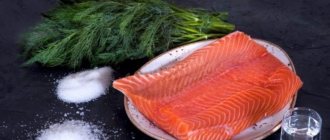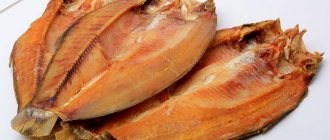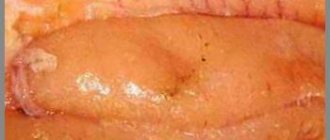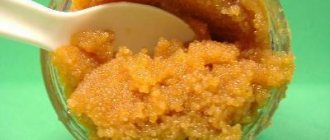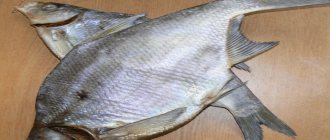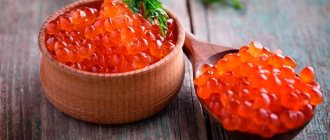For central Russia, the sale of ready-made lightly salted red fish is considered traditional. True, not everyone can afford this pleasure - the price is too high.
The price of fresh fish, and especially frozen fish, is much cheaper. If the fish is frozen once, it does not lose its taste at all and you can safely salt it yourself. This process is not at all labor-intensive and will not take much time.
Selection and preparation process
Naturally, the best product remains freshly caught fish. Only residents of the Pacific Coast can afford such luxury; the rest of the population has to be content with freshly frozen semi-finished products. In the huge refrigerators of specialized stores, you should pay attention to whole sockeye salmon carcasses without heads, frozen by shock. Be sure to carefully examine the preparations for the future delicacy before purchasing - there should be no traces of primary processing or suspicious stains on them.
At home, leave the fish to defrost in the refrigerator. Do not rush into thawing - any acceleration of this process can ruin an expensive product.
After the carcass has completely thawed, drain the water that appears in the bowl with the sockeye salmon - it is strictly forbidden to use it for cooking broth, as some sites recommend.
Next, rinse the sockeye salmon thoroughly in running water and cut off the fins and tail with culinary scissors. Using a sharp knife, carefully open the belly and remove all the insides with your hands. Carefully examine the entire mass that ends up in the plate - the slightest signs of worms indicate that the product needs to be thrown away. In order to save money, I do not recommend using an infected product - the larvae of all marine parasites have too high a degree of survivability. But the consequences of infection are impossible to predict.
If upon inspection everything turns out to be perfect, carefully separate the caviar or milt. They can also be salted. Scrape the black film from the walls of the belly with the back of a knife so that the finished delicacy does not become bitter.
Rinse the prepared carcass and entrails in plenty of water and place in a colander or thick sieve - we don’t need excess water. As soon as the water stops dripping, wipe the workpiece with a linen napkin. Our further actions directly depend on how you want to salt sockeye salmon.
Choosing fish for salting
Residents of the Far East can buy unfrozen and even live fish.
Many stores in this area of the country sell live fish in regular supermarkets. It can also be purchased in the morning from fishermen.
There are several rules for choosing unfrozen fish:
- if there are several individuals in the store, then you need to buy the most mobile and active of them,
- red and elastic gills indicate the freshness of sockeye salmon,
- If the fish is fresh, then when you press on the skin, the dent quickly disappears.

In most regions, fish can only be bought frozen. You should not choose a carcass if it is covered with rusty spots. They talk about fat oxidation and product staleness. When choosing a carcass, you need to pay attention to the eyes. They must be transparent. Some housewives also carefully examine the contours of the fish. The presence of sharp corners indicates repeated freezing of the carcass.
Some housewives think that small fish are the most delicious and healthy. This is not entirely true, because salmon gains weight very quickly, so a large mass does not indicate old age of the individual. The disadvantage of small carcasses is the abundance of bones. They are difficult to remove when cutting fish .
Sockeye salmon fillet in brine
My favorite way to prepare this delicious fish. You need to cut the pre-cleaned carcass along the ridge very carefully and pull out the spine along with the large bones. Next, we spread both halves on the table and carefully examine each piece, pulling out the remaining bones with tweezers.
What we need:
- 1 kg sockeye salmon fillet;
- 5-9 tbsp. l. table salt;
- 1 liter of purified drinking water;
- 200 ml refined oil.
How to prepare:
- Dry the fillet with skin lightly with a kitchen napkin.
- Place a saucepan of water on the fire and add salt to the boiling water. As soon as the crystals dissolve, remove the brine from the stove and wait until it cools. Strain through several layers of gauze - rock salt contains a lot of insoluble particles, which will then crunch unpleasantly on your teeth.
- Place whole pieces of fillet in lukewarm salted water for 30 minutes. Don’t be afraid to overdo it with salt – this fatty fish will never take too much.
- Now we take the salted sockeye salmon out of the liquid and lightly blot it with a paper towel.
- Cut the delicacy into portions and place in a glass or plastic container with a lid.
- Fill the treat with oil. If you wish, you can add spices to the red fish at this stage. I use ground allspice and crushed bay leaf.
- Close the jar of fish tightly with a lid and place it in the refrigerator for 10 hours.
You can use this preparation in any way you like – from breakfast sandwiches to complex salads.
How to properly salt sockeye salmon
In terms of its taste, sockeye salmon is considered one of the most delicious when comparing the entire salmon family. The meat is quite fatty, which allows it not only to be salted, but also to be smoked. Chum salmon and pink salmon are not entirely suitable for this, as they turn out dry.
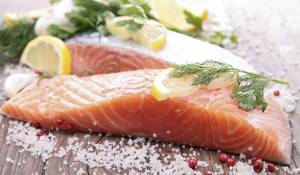
General cooking tips
- Considering the fact that this type of salmon is quite fatty, it will take some time to salt it. The sample can be taken after a few hours, but it will not yet be a finished product. To get lightly salted, you need to wait about a day, then transfer the fish from the salting container into a bag and leave it for a day.
- Pickling such a product fresh is dangerous - it may contain parasites. It is recommended to freeze it for 21 days at a very low temperature (-18 degrees Celsius).
- When purchasing frozen fish, re-freezing is not required.
How to choose the right fish
- You need to buy exclusively fresh fish (live, chilled, and ideally first frozen).
- It doesn't have to be cleaned. You should buy a whole one. You need to cut it up yourself before salting.
- Caviar and even milk can also be used for salting; their taste is simply amazing.
How to prepare a product for salting

To prepare you will need:
- Culinary scissors;
- A small but fairly sharp cutting knife;
- Salting container;
- Oppression;
- Prepared mixture.
When preparing, you must follow certain rules:
- Defrosting. Under no circumstances should you use a microwave oven. The product is simply left for a couple of hours in a warm place.
- A plastic container or an enamel pan is suitable for pickling. The main thing is that there are no chips on it.
- The best way to remove fins is to use scissors.
- Particular attention is paid to the mixture. The final result of the preparation depends on how correctly it is prepared.
- For oppression, a regular bottle filled with water may be quite suitable.
How much to salt sockeye salmon?
Sockeye salmon, like all fatty fish, is not afraid of salt. It is almost impossible to over-salt it. She simply will not take in excess salt. For complete salting, 2 days are enough for it. Lightly salted can be eaten after 24 hours. To ensure even salting, it should be turned over from time to time in the resulting juice.
Dry pickling
A quick and low-budget option for preparing a healthy delicacy. You should not be afraid that as a result of such processing the sockeye salmon will become dry - the special structure of the tissues in the muscles of the red fish will not allow seasonings and spices to spoil the juicy preparation.
What we need:
- 1 kg of fish without bones;
- 4 tbsp. l. table salt;
- 2 tbsp. l. granulated sugar;
- 1 tsp. spices to taste.
How to prepare:
- Carefully remove the skin from the prepared fillet.
- Sprinkle the mixture of dry seasonings and spices evenly over the surface of the fillet on both sides.
- Wrap the sockeye salmon in parchment and place it in the refrigerator for a day. Be sure to place a deep plate under the package - during the salting process, the fish will give juice.
Before using, I lightly wipe lightly salted fish with a paper towel so that undissolved grains do not get into the sandwich or salad.
How to salt red fish at home - recipes
How to salt red fish at home: recipes, the advantages of a homemade delicacy over a store-bought product, subtleties and methods of preparing it.
Red fish can be either an independent dish or a noble appetizer. Its most delicious varieties are salmon, trout, sockeye salmon, pink salmon, chum salmon, nelma and white fish. And they are most useful after cold smoking or home pickling.
Homemade salting of red fish has undeniable advantages:
- the resulting meat is very tender, which retains its natural advantages and beneficial properties, which cannot be said about a store-bought product: it usually contains a lot of salt and also contains preservatives;
- Red fish cannot be spoiled by salting: the meat of these aquatic inhabitants will take exactly as much salt as needed; excess salt simply will not be absorbed.
But how to properly and tasty salt red fish at home? What breed of fish family should I buy? Which salting method should I choose? We will tell you about all this in detail.
Buying fish
The most crucial moment is the purchase of the “hero of the occasion”: it must be fresh and uncut; you need a whole fish carcass, chilled or frozen. The most tender meat is found in salmon, sockeye salmon and trout.
But chum salmon and pink salmon may turn out a little dry; When salting, it is advisable to season them with olive oil. In addition, salmon and trout are larger fish: their fillet pieces look much more beautiful when cut.
Preparing for pickling
You will need a sharp cutting knife, a pickling mixture, culinary scissors and a fish container. An enamel saucepan or plastic container will do. It is better not to use metal dishes, because brine is an aggressive environment: after being in such a container, the fish may develop an unpleasant “iron” taste. You need to defrost the carcass naturally, at room temperature.
Fish cutting
Use a knife to cut off the head of the fish, and cut off the fins with culinary scissors. Cut the belly lengthwise and remove all the entrails.
- If you find caviar inside, you need to carefully remove it, remove the film, treat it with boiling water for disinfection and place it in salted water for 10 minutes (2 tablespoons of salt per 0.5 liter of warm (!) water). If you find milk inside, carefully rinse it and salt it along with the carcass.
- But let's get back to the fish. After you have freed the belly from the entrails, you need to clean the fish from the bones. Using scissors, make cuts to the right and left of the spine to separate it from the rest of the bones: they can then be easily removed by hand. If the carcass is large, you can cut it in half.
Preparing the pickling mixture
The mixture for salting fish is prepared from salt and sugar. For 1 kg of meat you will need about 3 tablespoons of the mixture. The salt should be coarsely ground; it will allow the fish to salt in its own juice.
If desired, you can use other spices:
- bay leaf (3-4 pieces per carcass),
- allspice peas,
- mustard,
- crushed coriander,
- any greens,
- aromatic herbs - what you love;
- but even without them, red fish will turn out very tasty.
An improvised oppression will also work - for example, a jar filled with water: a plate is placed on the fish placed in a bowl, and a weight is placed on it that will press the meat. To make it easier to cut the fish after salting, you need to lightly freeze it.
Salting red fish: recipes
Recipe 1. Red fish under pressure
You will need:
- 1 kg of fish,
- 2 tablespoons salt,
- 1 tablespoon granulated sugar.
Mix salt and sugar, thoroughly rub the carcass with the resulting mixture, place it in a bowl, build a pressure and let the fish “rest” for a couple of hours in a warm place. Then the carcass will need to be cleaned of excess salt and placed in the refrigerator for a day.
Recipe 2. Dry salted red fish
You will need:
- 1 kg of fish,
- 2 tablespoons each of salt and granulated sugar,
- 1 teaspoon each of coriander seeds and black peppercorns,
- bay leaves,
- a piece of clean cotton cloth.
Rub the carcass with a mixture of salt and sugar, sprinkle with spices and place bay leaves on the inner side of the fish. Sprinkle a towel with one tablespoon of salt, place the carcass on it, skin to fabric, and “swaddle” it tightly.
After this, wrap the fish in paper towels, place in a bowl and refrigerate for 2-3 days. In the morning and evening, be sure to change the paper towels and turn the fish from side to side. There is no need to touch the fabric.
Recipe 3. Red fish in soy sauce
You will need:
- 1 kg of fish,
- 4 tablespoons each of salt and soy sauce,
- 2 tablespoons granulated sugar,
- juice of one lemon.
Mix salt, sugar, lemon juice and soy sauce. Rub the carcass with the marinade, place in a bowl, cover with film and place in the refrigerator. After 24 hours, transfer the fish to a jar and cover with vegetable oil, but if you are going to eat it quickly, this is not necessary.
Recipe 4. Red fish with dill
You will need:
- 1 kg of fish,
- 2 tablespoons each of salt and granulated sugar,
- 200 g dill.
Rub the fish thoroughly with a mixture of salt and sugar. Rinse the dill and dry on a towel. Cover the bottom of the salting dish with a third of the sprigs, place half of the fish on them, skin side down, and cover it with the second third of the dill.
The last layer is fish again, only now it needs to be placed skin side up and covered with dill again. Build a bend, let the carcass stand for 7-8 hours at room temperature, and then put it in the refrigerator.
After two days the fish will be ready.
Recipe 5. Red fish in marinade
You will need:
- 1 kg of fish,
- 100 ml vegetable oil,
- 2 tablespoons salt,
- 1 teaspoon granulated sugar,
- Bay leaf,
- black peppercorns,
- onion cut into half rings.
First you need to prepare the brine: to do this, mix the butter with sugar and salt. If desired, add spices to the brine: pepper, bay leaf and onion.
Cut the fish into pieces, mix thoroughly with the brine, place in a clean jar and place in the refrigerator for 8-10 hours. The result is lightly salted, very tasty, tender fish, it just melts in your mouth.
This recipe for salting red fish is ideal for chum salmon and pink salmon, because they are not as fatty as salmon and trout.
Serving the finished fish to the table
When salting red fish, a lot of brine is formed. You cannot rinse a salted carcass; you need to remove it from the container and clean it of spices with a soft brush, and remove the brine with a clean napkin.
The cleaned fish is cut into pieces, placed lemon slices next to it on a plate (you can lightly sprinkle the slices with lemon juice, this is what everyone likes) and sprinkle this yummy with fresh, finely chopped herbs - parsley, dill, cilantro.
Different methods of salting red fish allow you to create real fish delicacies with a divine taste, which you can please your loved ones and surprise your guests. Enjoy your meal!
Source: https://f-journal.ru/zasolka-krasnojj-ryby/
Spicy salted sockeye salmon
- sockeye salmon fillet – 2 kg;
- Fillet the sockeye salmon and cut it into large pieces.
- Mix salt and sugar.
- Combine spices in a separate bowl.
- Wash the lemons, dry with a kitchen towel, cut into thin slices.
- Add a couple of tablespoons of the sugar and salt mixture to the bottom of a bowl or container. Place the first layer of fish.
- Sprinkle the fish with sugar, salt, and spicy mixture. Add lemon slices.
- Place the next layer of fish, cover it with salt, sugar, spices, and lemon slices. Place the rest of the fish in the same way.
- Cover the fish with gauze and a plate, put it in the refrigerator.
It will be possible to take a sample within 24 hours, but it is still recommended to salt sockeye salmon using the indicated method for 2 days.
Cooking features
The process of salting sockeye salmon with your own hands is quite simple, and if you know and take into account several important points, you can cope with this task even without much culinary experience.
- In most regions of our country, sockeye salmon is sold frozen. When purchasing it, it is important to pay attention to its expiration date and the integrity of the packaging. But even if the packaging is in order and the expiration date has not yet expired, it is important to assess the condition of the fish visually. It should not be covered with a thick ice crust with sharp corners, and there should be no snow or water in the package. These are all signs that the fish has been thawed and re-frozen, possibly more than once. The presence of rusty spots on the fish also indicates that it is not fresh.
- It is more profitable to buy undressed sockeye salmon. Firstly, such fish are initially cheaper. Secondly, you can hope to receive a bonus in the form of red caviar. Even if there is milk inside, there is no reason to be upset; you can also make delicious dishes from it.
- Before salting, even gutted fish must be thawed, cleaned, cut into fillets or steaks, if the recipe calls for salting the fish in such pieces. Fish should be defrosted gradually, avoiding sudden temperature changes. You should not speed up the process using a microwave or hot water, as this can cause the fish to become loose and dry.
- After defrosting, the fish is washed, dried with a towel, then gutted by carefully cutting the belly. The incision is made carefully so as not to damage the gallbladder. In addition, there may be caviar inside, which is also not advisable to damage.
- After removing the entrails, the sockeye salmon's head, tail, and fins are cut off. These parts should not be thrown away, as they can become the basis of a delicious soup.
- All that remains is to cut the fillet from the ridge and start salting. Some housewives also separate the fillets from the skin, but in fact, the traditional technology for salting red fish does not involve peeling the fillets from the skin.
- You can salt sockeye salmon dry or in liquid brine (brine). The choice of recipe depends on the gastronomic preferences of the cook.
- Do not use aluminum dishes for salting fish, especially if the brine contains acidic foods. This material quickly reacts with acids, resulting in the formation of harmful substances, and the snack itself acquires an unpleasant metallic taste.
Typically, sockeye salmon needs to be salted within 24-72 hours, but there are recipes by which the appetizer can be prepared much faster (in 3 hours). In the latter case, you will have to use lemon juice or even vinegar.
Several quick cooking recipes
How to pickle trout at home quickly and tasty? There are several quick cooking recipes.
Rub the fillet pieces with salt and sugar, add dry dill and a little vodka. All ingredients are taken in small quantities. Place the fish in a container and press under pressure for several hours. Then, after two hours, put the pan in the refrigerator. After six hours the trout is ready.
There is another recipe for quick pickling. The trout must be cut into thin slices, and then put pieces of fish, pepper, salt, bay leaf and olive oil into a jar in layers. All spices and their quantity must be selected independently to taste. You can experiment with the components. For example, you can add lemon or orange to the jar. The dishes are closed, shaken several times and placed in a cold place for six hours. The fish is ready.
Trout can be salted ten hours in advance. For one kilogram of fish you need to take three teaspoons of salt and half a glass of refined oil. Wipe the cut fish with napkins and cut into pieces. Place the slices in a bowl, add salt and add oil, mix all ingredients well. Next, put the pan in the refrigerator. Ten hours later the trout is ready.
Step-by-step recipe with photos
For salting sockeye salmon, unlike other types of red fish, only frozen fish is used. More precisely, defrosted. Deep and complete, and preferably shock, freezing is recommended for safety reasons. I won’t spoil your appetite and write specifically why, just believe me and take note!
For pickling, only salt is enough, but additionally sugar, peppers and even alcohol can be added. Use sea salt or coarse salt.
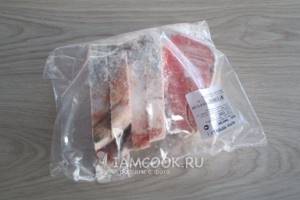
To salt sockeye salmon at home, defrost it at room temperature or transfer it from the freezer to the refrigerator.
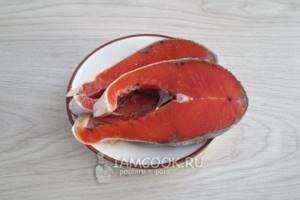
Rinse thawed steaks, fillets or other pieces of sockeye salmon in cold water, wipe with napkins and dry.

Sprinkle the surface of the sockeye salmon on all sides with salt and sugar. If desired and to taste, add spices, such as crushed allspice peas.

Place the fish in containers, preferably airtight, because... They are convenient for turning fish over during cooking. If you salt in a different type of container, simply turn the pieces of fish over to the other side using a fork or spatula.
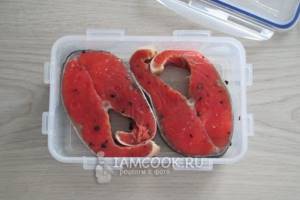
During two days of salting, you need to turn the sockeye salmon at least once, and preferably 2-4 times at regular intervals.
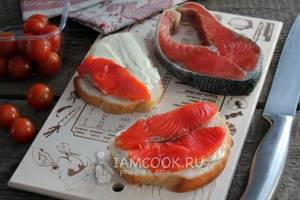
Salting sockeye salmon at home is complete. Remove the skin and scales from the fish, remove the bones with tweezers and serve the salted sockeye salmon fillet as part of salads or appetizers.
Cutting
Tip: It is very convenient to cut fish with scissors. They cut everything very easily. You can take a knife of medium length; it will help peel the meat from the ribs.
Another tip: it is more convenient to cut fish if it is not completely defrosted.
Cut off the tail and head, if any. A lot of fish is sold gutted; cutting it is more convenient and easier.
Clean off the scales and then wash the fish. It doesn’t always need to be cleaned, but if there are a lot of scales on the skin, you won’t get rid of them later.
Cut the skin along the ridge, going around one or both sides. Use your fingers to separate the ridge on one side, reach the backbone with your hand and separate all the back meat from the bones.
Cut out the ventral fins with scissors.
Turn the fish over so that the separated part is on the bottom and the bones are on top. Helping yourself with a knife, separate the ribs from the meat, then the tail part of the ridge.
If there are films left in the area of the insides, remove them. But the main film goes away along with the ribs.
Separate the dorsal fin, and also cut out the fin from the bottom of the tail.
And use a knife to separate the ridge from the second half of the fish. It’s also better to start at the top and then tear off the ribs.
And you got two halves of red fish fillet.
If you wanted to use some of it for steaks, then, of course, you first had to cut them off, and then fillet the fish.
Instead of an afterword
In our article we have presented the main ones. As you can see, there is nothing complicated in preparing the delicacy yourself. The main thing is to be able to choose a quality product. And then the salted red fish will turn out very tender and tasty.
It is necessary to thoroughly wash the fish and remove all entrails, then pat dry with a napkin. Correctly cut trout or sockeye salmon, pink salmon, salmon, coho salmon, chum salmon into portions along the ridge. Now you can start the salting itself. To do this, you need to calculate the following ingredients per kilogram of fish:
1. Two tablespoons of coarse salt. 2. One tablespoon of sugar. 3. Half a tablespoon of seasoning for fish, namely for salting (preferably Avokado).
Mix all this and rub the outside and inside of the fish with this mixture. To finish, you need to sprinkle a few drops of lemon juice on the fish and, placing the fish in an enamel bowl, place a weight on top. We hide the fish in the refrigerator for a day or a day and a half, after which you can enjoy delicious salted fish, but first remove the layer of seasoning and juice from it.
Video on how to quickly salt red fish
Quick salted sockeye salmon
- sockeye salmon fillet – 1 kg;
- salt – 100 g;
- water – 0.25 l;
- apple cider vinegar (6 percent) – 20 ml;
- refined vegetable oil – 20 ml;
- onions – 100 g;
- allspice – 10 pcs.
- Grind allspice using a special mill.
- Cut the fish into fillets and sprinkle with pepper.
- Dissolve the salt in warm water, strain the brine solution and cool to room temperature.
- Pour brine over the sockeye salmon and leave in the refrigerator for 2 hours.
- Drain the brine. Cut the sockeye salmon fillet into thin slices and place on a plate.
- Peel the onion and cut into thin half rings.
- Mix vinegar with oil, pour the resulting mixture over the fish.
- Sprinkle the sockeye salmon with onions.
- Place the fish dish in the refrigerator for 30-60 minutes.
After the specified time, lightly salted sockeye salmon can be safely served.
Lightly salted sockeye salmon is a real delicacy. It will turn out delicious and won’t cost too much if you salt it yourself. This can be done using several recipes, each of which is good in its own way.
How to simply salt red fish
Red fish is an excellent food that many people enjoy. There are many types of red fish - salmon, trout, salmon, masu salmon, pink salmon, chum salmon, coho salmon, sockeye salmon and many others.
There are even more ways and recipes for preparing salmon fish. One of the simplest, most delicious and popular recipes is cooking lightly salted fish.
Today I will tell you two recipes, two simple ways to salt red fish at home.
When you first see a salmon fish in cross-section, you see its red meat, fillet, there is no limit to your surprise. Nature has worked hard!
- The trick is that salmon fish change skin color and meat color, depending on where the fish is located. While chum salmon or pink salmon are feeding in the sea, they are “silverfish”, i.e. has a light silvery skin color. And inside there is very red bright meat. Sockeye salmon and, to a slightly lesser extent, coho salmon are especially famous for their redness.
- Chum salmon, pink salmon, masu salmon, as well as Atlantic salmon are somewhat paler.
- As soon as the red fish enters the river to spawn, its appearance begins to acquire a dark color, the so-called. breeding plumage (bright or dark stripes, spots). But the fish meat, on the contrary, begins to turn pale.
- And very high up the river, in the spawning area of the fish, the meat loses its redness almost completely. So, red fish caught in bays, near river mouths and in their lower reaches is considered the most valuable.
Well, let's move away from theory and go to the market to buy red fish. Yes, this is the case in the Far East, and here fresh or frozen red fish of excellent quality can be bought all autumn and the first half of winter, just on the market for very modest money. Residents of other regions will have to go to the supermarket and rely on the quality of the frozen food they purchase.
So, the first way to salt red fish at home. For this method, I took a whole coho salmon and half a chum salmon. I left the other half of the chum salmon to show you, just below, the second salting method.
If the fish is fresh, then a lot depends on whether it is a female, and at what stage of maturity the caviar is (if the fish was sold with caviar, well, if you yourself caught a female red fish, the answer is obvious...).
- If the fish is caught at sea, near the mouth or in the lower reaches, then most likely the caviar is in the so-called. bags. Then we carefully rip open the fish’s belly and take out the eggs. If the caviar is already completely ripe and the fish was caught shortly before spawning, then the caviar can simply be milked.
- We substitute a bowl and, lightly pressing on the abdomen, squeeze the caviar.
Having removed the fish caviar or milt for other purposes, we continue preparing the red fish for salting. We remove the entrails and cut off the head. The head will go to the ear. You can also add the tail of the fish there. We wash the fish, wipe off all the dirt, remaining blood and remaining water from the internal cavity using disposable kitchen towels.
If the fish is frozen, then let it defrost completely naturally, at room temperature. If the fish is uncut, then remove the entrails and head, as described above. If you bought already cut fish without a head, then simply wipe the inner cavity with towels, without washing it.
Using a sharp knife, cut the fish lengthwise along the ridge. And, as it were, we unfold, reveal the fish. If the fish is very thick and large, then you can make several transverse cuts along the back so that it is better salted.
Let's prepare the mixture for salting. For this we need coarse kitchen salt and granulated sugar. Typically a one to one ratio is used. But, if you want it saltier, you can use 2 parts salt to 1 part sugar. For 4 kg of prepared fish, I took two medium-heaped tablespoons of salt and 1 tablespoon of sugar. Mix salt and sugar.
- For the further salting process, we need a fairly large piece of cotton fabric, for example, a piece of an old sheet, etc. (the fabric is naturally clean, pre-washed).
- Spread the fabric on a clean floor or large table. Place the flattened fish on the cloth with the skin on it. Sprinkle the surface of the fish evenly with a mixture of salt and sugar. Sprinkle evenly and sparingly.
- We put the halves of the fish salted in this way back.
- And wrap the fish tightly in fabric. And we leave it wrapped in this way for 3-5 days, depending on the size of the fish. We have large fish, so we will salt the fish for 4.5-5 days. If we salted medium-sized salmon or pink salmon, then 3 days would be enough.
- During the salting process, we turn the fish from side to side 1-2 times a day. When time has passed, we simply remove it from the fabric, put the fish in a bag and put it in the freezer. Fabric - in the wash, until the next portion of salting.
We take this fish out of the freezer and let it thaw when needed. When the fish has not yet completely thawed, cut it into thin strips. We remove bones and fragments of the ridge. And, when the red fish has completely thawed, we use it for sandwiches, tartlets or other servings of lightly salted red fish. It turns out excellent, very simply prepared lightly salted red fish at home.
The second method of preparing lightly salted red fish is perhaps even simpler than the previous one.
In our case, we salt chum salmon. When the fish is not yet completely defrosted, cut it crosswise into pieces about 2-2.5 cm thick. For salting, we need a medium food-grade plastic bucket with a lid. For example, a container for salted herring or other fish...
Pour a few small pinches of salt into the bottom of the bucket. Place a layer of fish. The main thing is that it is denser. It all depends on the cross-sectional size of the fish and the cross-sectional area of the bucket. This can be either one piece - one layer, or 2-3 pieces of fish per layer.
Sprinkle salt on top of the laid layer of fish, also sparingly, sprinkle 2-3 small pinches of salt evenly on the cut of the fish. Next is the next layer, and so on, until the bucket is almost completely filled. Amount of salt by eye.
Taste and, depending on the salinity of the resulting fish, adjust the degree of salting of the next batches.
And fill the entire bucket with sunflower oil. Press down on the fish with your hand to release air bubbles. You need to ensure that the oil completely covers the fish.
We close the bucket with a lid and put it straight into the refrigerator (we don’t keep it in the room or in the freezer, but simply in the regular compartment of the refrigerator). After 4 days, the fish is ready to eat.
Here are two simple and extremely successful recipes for salting red fish at home. I salted chum salmon, salmon salmon, coho salmon, sockeye salmon, and pink salmon this way - and it always turned out great!
Source: https://topkuhnya.com/blyuda-iz-ryby/kak-prosto-zasolit-krasnuyu-rybu.html
How to salt caviar: how much salt is needed
There is a general principle on how to salt red caviar, and indeed any fish caviar (for example, carp, herring, peled and other species). To obtain a product with a typical taste of moderate salting, similar to what you get at the market or in a store, the amount of salt should be about 7-8% of the weight of the fish.
Thus, it is enough to take 40 g of salt per 500 g of caviar. If you measure in tablespoons, you get 2 level tablespoons of salt. In this case, you need to take a little less finely ground salt than coarse salt. After all, small grains are more dense, which means that the mass in the same volume increases.
However, there are lovers of both lightly salted and heavily salted foods. Therefore, it is useful to know about the general principles of salting based on the ratio of salt to the main product.
| degree of salinity | weight of salt, % of product | example for 500 g of caviar |
| lightly salted product | 5-7% | 30 g salt (1.5 tablespoons) |
| average salinity | 8-10% | 50 g salt (2 tablespoons) |
| highly salted product | 11-12% | 60 g salt (2.5 tablespoons) |
Thus, we measure the mass of salt for salting caviar using tablespoons and remember that:
- 1 level tablespoon contains about 20 g of salt;
- in 1 heaped tablespoon – 30 g of salt.
It is important to understand that the degree of salinity also depends on the duration of cooking. For example, even if you take a obviously large amount of salt, but keep the caviar for only 1-2 hours, you will end up with a lightly salted product. It is completely safe for health, you just need to use it within 1-2 days.
NOTE
The data is based on dry salting, i.e. without the participation of water. If you dilute salt with water, it all depends on the volume of liquid. The corresponding ratios are given below.
Sockeye salmon baked in the oven with potatoes and spices
Usually red fish is cut into pieces (steaks), which are then baked, but here we suggest baking the whole fish.

You will need:
- medium fish;
- 1.2 kg of potatoes;
- 5 fennel bulbs;
- greenery;
- 2 lemons;
- olive oil;
- salt and pepper to taste.
Before you take on the fish, you need to prepare a pillow. Peel the potatoes, wash them and cut them into slices. Place them on a baking sheet and add spices to taste. Cut the fennel bulbs into several pieces and place on top. Pour vegetable oil over everything and the pillow is ready.
Start preparing the fish. Clean it, wash it and dry it. Then make 5 vertical cuts on both sides, rub in salt and pepper. Prepare a mixture that should also be rubbed onto the fish. Chop the greens and mix them with lemon juice.
Now you can place the fish on the pillow, first filling it with lemon slices. After preheating the oven to maximum temperature, bake the dish for 15 minutes. Then turn the temperature up to 180 degrees and cook for another 30 minutes.
Pour olive oil over the finished dish and sprinkle with lemon juice. When you cut the fish, you will immediately see a juicy fillet, and when you taste it, you will hear spicy notes thanks to the spices.
A simple recipe for salted sockeye salmon
Compound:
- sockeye salmon – 1 kg;
- salt – 50 g;
- sugar – 10 g.
Cooking method:
- Gut the sockeye salmon, remove the fins, tail, and head. Cut the fish into steaks no more than 2 cm thick.
- Mix salt and sugar. Rub the pieces of fish with the resulting mixture, put them in a container and put them in the refrigerator.
- Salt the fish for 3 days, turning the pieces to the other side 2 times a day.
All that remains is to peel the pieces of fish from the skin, separate the fillets from the bones, after which the sockeye salmon can be served as an independent snack or used for making sandwiches, salads, and other dishes.
